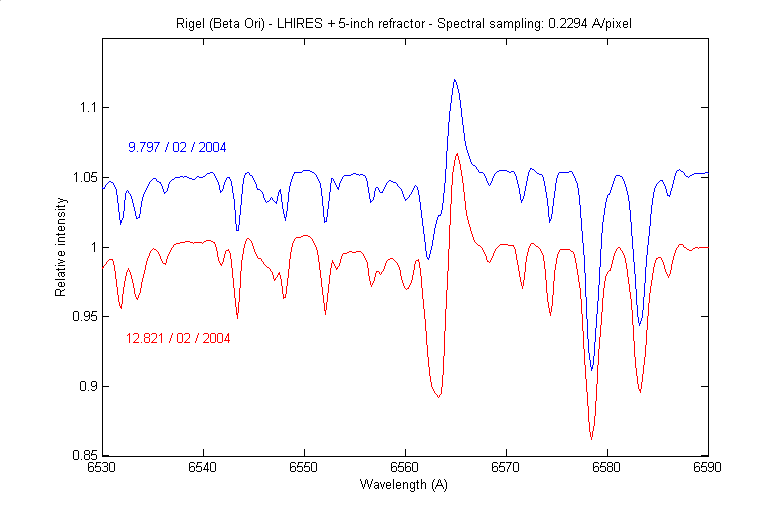
LHIRES
III
Littrow
HIgh
REsolution
Spectrograph
|
|
LHIRES
III |
INTRODUCTION
LHIRES III spectrograph having a resolution of up to 16 000 around the Ha. line. This spectrograph is with details some of spectra, in particular for survey of active stars such Be type. The design of LHIRES is economic (Littrow assembly = only one objective) and relatively light taking into account the spectral resolution (approximately 3 kg, Audine CCD camera included). In counterpart, the instrument can be used only on telescopes or refractors of moderate focal ratio (near f/8... f/10). It is in particular well adapted to the family of the Schmidt-Cassegrain telescopes (f/10 relative focal ratio) or some modern apochromatic refractors. Dispersion of 0.115 A/pixel is acheavable with a 2400 grooves/mm grating. The resolution of the spectrograph is adaptable by changing the diffractive grating. A setup permit to autoguide during exposure. The camera can be a CCD type, but also a commercial DSRL.
CLICK HERE FOR MORE INFORMATIONS ABOUT THE LHIRES III SPECTROGRAPH
EXAMPLE OF HIGH RESOLUTION SPECTRA GIVEN BY LHIRES III
The entrance slit width is of 20 Ám for a spectral resolution of 17000. The telescope used is a Celestron 11.
|
|
|
|
|
|

SPECTROHELIOGRAPHIC MODE

Francois
Cochard et Christian Buil at the Astrophysical School of La Rochelle (May 2006).
Lhires III is tested on the Sun.
Examples of spectroheliogram taken with the LHIRES III spectrograph equipped with a Watek 120N (30 may 2006). A camcorder SONY DCR-HC90E is used for store the sun scan on a DV-band. The image is processed with Iris:


First light of a standard Lhires III used in a spectroheliographic mode (17 may 2006)
For details about the techniques, click here.
SOME SCIENTIFIC PROGRAMS FOR
LHIRES III
1.
Ha
emission survey of high-luminosity supergiants
In the most luminous supergiant stars the continual or sporadic ejection of matter is a common phenomenon. Numerous stars of this type are accessible to the LHIRES III spectrograph and a moderate aperture telescope (8-inch typically). The variability of the H alpha profile is highly variable and spectacular on different time scales reaching from days to months. The purpose of this survey is alert concerning exceptional events, the measure of velocity fields in the outer atmospheric region of this stars, search of pulsation or rotational modulation (tomography - dynamic spectra) and hydrodynamic studies.
The figure below concern the star Rigel (Beta Ori) and show an evidence of the variation of Ha profile if we compare a UVES spectrum and LHIRES spectrum. Note that the spectral resolution of LHIRES III is sufficient to resolve the lines of this area of the spectrum. Telluric lines are visible (water vapour) and have been marked ("A" letter). The wavelengths are reported to the heliocentric system. The LHIRES observation is made in Toulouse (France) with a 5-inch refractor and a cumulative exposure time is of 650 seconds.

Three days evolution of Rigel Ha profile (between February 9, 2004 and February 12, 2004) :

Another familiar star with spectrographic interest, the active supergiant Deneb (Alpha Cyg):


For
a catalog and observations of supergiants click here
2. Observation of
hot and massive stars
Look for example short term (5 days interval!) spectacular evolution a massive bright star, Zeta Ori (the "familiar" star near the famous Horse Nebula), observed with the LHIRES spectrograph and a 5-inch refractor:


For
a catalog and observations of massive stars click here
3. Survey of Be stars
The Be stars are defined to be rapidly rotating O, B, A-type stars of luminosity classes III-V which Balmer emission lines. Many B stars show these characteristics, but the Be stars correspond only to the class of non-supergiants (classes III to V). Approximately 10% of the non-supergiant B-type stars present the characteristics of the Be stars.
A characteristic of the Be stars comes from the variability of aspect of the hydrogen lines (and sometimes, helium and iron). Stars can on a cycle of a few years show lines in strong emission, usually completely absent (confused with the continuum) or in absorption as in a normal star. The frequency of the variations of the profile lines covers a very broad range since some Be stars can show certain line-profile changes in a few hours or minutes whereas others can remain stable during years. Sometimes several cycles of variations with very different periods can be superimposed. For a complete review about Be stars, click here.
An example, the time evolution of the star Zeta Tau:




For
a catalog and observations of Be stars click here
4. RS CVn stars
RS CVn are class of detached binary typically composed of a chromospherically active G or K stars. The system generally rotate fast with typical orbital period from a few days to 20 days. Tidal forces between the close components have locked their rotational periods to the orbital period. The RS CVn binaries display a high level of activity with strong chromospheric line emissions. One of the striking aspects of these systems is their propensity to flare. These stars shows rotational modulation of photospheric spots.and are also magnetically active (Doppler Imaging and Zeeman Doppler Imaging are classical technique used for map stellar surfaces of the RS CVn components).
Here the two days evolution of the RS CVn star UX Aries:


For
a catalog and observations of RS CVn stars click here
5. Spectroscopic double stars
For pedagogical purpose (fine demonstration of Doppler effect and celestial mechanic) and because these objects are spectacular, the spectroscopic binary. Example, the fast swing of the component of 12 Boo:

